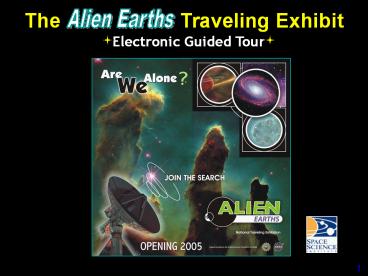The Traveling Exhibit - PowerPoint PPT Presentation
Title:
The Traveling Exhibit
Description:
The Traveling Exhibit Electronic Guided Tour 1 Key Partners Welcome to the Exhibit Our Place in Space (Powers of 10 display ... – PowerPoint PPT presentation
Number of Views:29
Avg rating:3.0/5.0
Title: The Traveling Exhibit
1
The Traveling Exhibit
Alien Earths
Electronic Guided Tour
1
2
Key Partners
2
3
Welcome to the Exhibit
Alien Earths
EXHIBIT AREAS
- Our Place in Space (Powers of 10 display)
straight back - Star Planet Formation to the right
- Planet Quest straight back
- Search for Life to the left
3
4
Alien Earths Floorplan (3,000 sq. ft)Major
Exhibit Areas
4
5
5
6
Our Place in Space
- Key Questions
- What and where are we in the cosmos?
- Could there be other planets like Earth out
there?
6
7
Our Place in Space
The BIG IDEA Our search for life beyond Earth
depends on our understanding of what and where we
are in the grander scheme of things.
7
8
Our Place in Space
Directly behind the Entrance Sign, there is a
wall-sized graphic depicting the big picture
with a Powers of Ten display from atoms to
galaxies - an excellent kick-off to any tour of
the Alien Earths exhibit.
8
9
Star and Planet Formation
9
10
Star Planet Formation
Key Question Where do planets come from?
BIG IDEA Planets sometimes form along with
stars. Our search for life beyond our solar
system requires us to know where and how.
10
11
Star Planet FormationLooking toward the Planet
Quest Area
Infrared Interactive
Planet Quest Area
Story of star planet formation
Design a Solar System
Spin Browser Stellar Life Cycle
11
12
Star Planet Formation
Exciting Interactives!
Mission Invisible Discover how infrared light
lets astronomers see through interstellar clouds
into star and planet forming regions in our
galaxy.
Design a Solar System Create and run your own
virtual solar system!
Pressure Ball Learn how gas and dust condense
to ignite nuclear fusion in stars as you pump up
the pressure in this explosive activity!
12
13
Star Planet FormationLooking from the back of
the exhibit
Where Do Planets Come From?
Salt Room
Planet Quest Area
Orrery of our Solar System
Model planets to scale in size
13
14
Planet Quest Area
14
15
Planet Quest Area
- Key Questions
- Are there other planets outside our solar system
where life could exist? - How can we see them so far away?
The BIG IDEA During the past decade, we have
discovered over 150 planets around other stars.
We find them using clever techniques by detecting
how they affect their parent stars.
15
16
Inside the Planet Quest Area
- Finding Planets Orbiting Distant Stars
Alien Earths News new planets being discovered
Planet Transit
Other Worlds
Planet Wobble
Coronograph
16
17
Planet Quest
Exciting Interactives!
Planet Transit When a planet passes in front of
a star, a tiny amount of light from the star is
blocked. Explore how this helps us discover new
planets with this hand-crank/photometer activity.
Planet Wobble Activity Discover how a planet in
orbit around a star causes the star to wobble
slightly another method used to find new
planets.
17
18
Search for Life
18
19
Search for Life
- Key Questions
- Could life exist on any planet?
- How would we find it?
19
20
Search for Life
BIG IDEAS Life changes the physical environment
and knowledge of these changes determines how we
look for life elsewhere. Our search for life
elsewhere begins with what we know about life on
Earth. This is the science of astrobiology.
Image courtesy of NASA Ames Research Center and
the NASA Astrobiology Institute
20
21
Search for Life
Exciting Interactives!
Listening for Life Is there anyone out there?
Learn how we are listening for intelligent alien
signals from other worlds! Can you sort out the
sounds from space?
Biomass Compare elements of Earths biomass and
discover that most of the life on Earth is
microbes! Animals and humans make up only 1 of
the life on Earth.
Molecules in Motion Explore how and why states of
matter change and how our search for life is
linked to our search for liquid water.
21
22
Search for Life
More Exciting Interactives!
Microbial Mat Discover what these real living
microbes do when you change the amount of light
falling on them!
Are We Alone? Use this computer to crunch the
numbers and calculate the possibility of
contacting intelligent aliens using the Drake
Equation!
Winogradsky Column Explore how microbes in this
jar coexist and separate into layers to suit
their needs.
22
23
The Salt Room demonstrates what 100 billion
grains of salt would look like the same number
as stars in our Milky Way galaxy! Is there life
out there?
Search for Life
This area also includes interactives showing how
astronomers count stars.
23
24
Ready Set EXPLORE!
Enjoy your visit to the Alien Earths exhibit!
For more information on the science behind the
exhibit, we highly recommend downloading the
Science Background Presentation from the Alien
Earths website under the education
section. Other great resources as well as
virtual and in-person workshops are also
available through the website. Thank you for
your kind attention.
24































